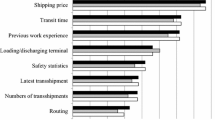Abstract
Orders for mega vessels with a capacity of more than 20,000 TEUs have bolstered the sector since 2014. Despite the fact that these mega vessels serve to reduce sea transportation costs and increase global trade, they, on the other hand, also need some port infrastructure and container handling equipment adjustments. This will likely produce higher peaks in port container traffic, which will have far-reaching consequences. A number of seaport and terminal industry players have taken the initiative to establish a floating terminal to cater for the demand, since the development of seaport terminals to meet the call of mega vessels has become such a pressing issue for the sector. The container floating terminal (CFT) is a floating infrastructure that has been developed with facilities to transport containers from larger container ships or load other cargoes on a short-stay platform and then transport them to smaller ships for shipment to end-users. Thus, the purpose of this research is to look into the impact of the CFT on the efficiency of Port Klang’s terminal operations and the local freight forwarding business. Using a questionnaire survey that was distributed among Port Klang’s employees and local freight forwarding companies, this study found that there is a relationship between the development of the CFT and the improvement of Port Klang’s terminal operations efficiency and the local freight forwarding industry.
Access this chapter
Tax calculation will be finalised at checkout
Purchases are for personal use only
Similar content being viewed by others
References
Baik JS (2017) The study on impacts of mega container ships on ports. J Supply Chain Manag 22–40
Frese F (2019) How mega ships impact terminals, ports and the environment. https://container-xchange.com. Accessed 18 July 2021
Hanjra M, Bhatti OK, Niazi S (2017) Understanding port efficiency: a CPEC perspective. J Manag Stud 4(1):90–101
Rahman N, Ismail A, Roslin M, Lun V (2018) Decision making technique for analysing performance of Malaysian secondary ports. Int J Shipp Transp Logist 10(4):468–496
Jeevan J, Roso V (2019) Exploring seaport dry ports dyadic integration to meet the increase in container vessels size. J Ship Trade 4(8):1–18
Ismail N, Mohd N, Jeevan J (2019) Emergence of mega vessels and their influence on future Malaysian seaport expansion requirements. J Undergrad Sci 1(1):58–67
Kutin N, Nguyen TT, Vallee T (2017) Relative efficiencies of ASEAN container ports based on data envelopment analysis. Asian J Shipp Logist 33(2):67–77
Jeevan J, Menhat M, Anuar D (2019) An empirical analysis on container vessels enlargement: exploring causal factors from the perspective of Malaysian maritime trade system. Int J Recent Technol 8(1S):366–373
Maletic J, Prigoda L, Cekerevac Z (2018) Technical solutions and assessment of economic effects of construction of an offshore terminal. MTC-Aj.Com. https://mtc-aj.com/technical-solutions-and-assessment-of-economic-effects-of-construction-of-an-offshore-terminal.1597.en.htm. Accessed 1 July 2021
Songhurst B (2017) The outlook for floating storage regasification units (FSRUs). Oxford Institute for Energy Studies. https://ora.ox.ac.uk/objects/uuid:cd2f183a-24c0-4c03-a697. Accessed 1 July 2021
Giranza MJ, Bergmann A (2018) An economic evaluation of onshore and floating liquefied natural gas receiving terminals: the case study of Indonesia. In: IOP conference series: environment earth science, vol 150, no. 1, p 012026
Arip M, Zainol H, Rashid K et al (2018) Intermodal freight transport terminal planning in Malaysia: assessing goods transportation and distribution system performance. Int J Acad Res Bus Soc Sci 8(11):1758–1771
Nasir S, Muhammad A, Jaafar H (2018) Factors influencing the increased usage of intermodal for container movement in Malaysia. Adv Transp Logist Res. https://proceedings.itltrisakti.ac.id/index.php/ATLR/article/view/55/55. Accessed 1 July 2021
Chudasama K M (2020) Port developments: relationship between port traffic of Gujarat and its Hinterland. Gujarat University Publication. https://www.researchgate.net/publication/346823111_port_development_relationship_between_port_traffic_of_gujarat_and_its_hinterland. Accessed 1 July 2021
Souravlias D, Dafnomilis I et al (2020) Design framework for a modular floating container terminal. Front Mar Sci 7(545637):1–17
Hlali A (2018) Tunisian seaport and globalization: the challenges of the first generation ports. Int J Econ Manag Strategy 14(1):61–69
Author information
Authors and Affiliations
Corresponding author
Editor information
Editors and Affiliations
Rights and permissions
Copyright information
© 2022 The Author(s), under exclusive license to Springer Nature Switzerland AG
About this paper
Cite this paper
Azmi, N.A., Md Arof, A. (2022). The Implication of the Container Floating Terminal on the Efficiency of Port Klang’s Terminal Operations and Domestic Freight Forwarding Industry. In: Ismail, A., Dahalan, W.M., Öchsner, A. (eds) Design in Maritime Engineering. Advanced Structured Materials, vol 167. Springer, Cham. https://doi.org/10.1007/978-3-030-89988-2_12
Download citation
DOI: https://doi.org/10.1007/978-3-030-89988-2_12
Published:
Publisher Name: Springer, Cham
Print ISBN: 978-3-030-89987-5
Online ISBN: 978-3-030-89988-2
eBook Packages: EngineeringEngineering (R0)




